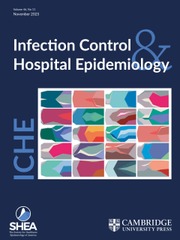Article contents
Infection Prevention and Control Guideline for Cystic Fibrosis: 2013 Update
Published online by Cambridge University Press: 10 May 2016
Extract
The 2013 Infection Prevention and Control (IP&C) Guideline for Cystic Fibrosis (CF) was commissioned by the CF Foundation as an update of the 2003 Infection Control Guideline for CF. During the past decade, new knowledge and new challenges provided the following rationale to develop updated IP&C strategies for this unique population:
1. The need to integrate relevant recommendations from evidence-based guidelines published since 2003 into IP&C practices for CF. These included guidelines from the Centers for Disease Control and Prevention (CDC)/Healthcare Infection Control Practices Advisory Committee (HICPAC), the World Health Organization (WHO), and key professional societies, including the Infectious Diseases Society of America (IDSA) and the Society for Healthcare Epidemiology of America (SHEA). During the past decade, new evidence has led to a renewed emphasis on source containment of potential pathogens and the role played by the contaminated healthcare environment in the transmission of infectious agents. Furthermore, an increased understanding of the importance of the application of implementation science, monitoring adherence, and feedback principles has been shown to increase the effectiveness of IP&C guideline recommendations.
2. Experience with emerging pathogens in the non-CF population has expanded our understanding of droplet transmission of respiratory pathogens and can inform IP&C strategies for CF. These pathogens include severe acute respiratory syndrome coronavirus and the 2009 influenza A H1N1. Lessons learned about preventing transmission of methicillin-resistant Staphylococcus aureus (MRSA) and multidrug-resistant gram-negative pathogens in non-CF patient populations also can inform IP&C strategies for CF.
- Type
- Research Article
- Information
- Infection Control & Hospital Epidemiology , Volume 35 , Issue S1: Cystic Fibrosis Foundation Guideline , August 2014 , pp. s1 - s67
- Creative Commons
- © Lisa Saiman, Jane D. Siegel, John J. LiPuma, Rebekah F. Brown, Elizabeth A. Bryson, Mary Jo Chambers, Veronica S. Downer, Jill Fliege, Leslie A. Hazle, Manu Jain, Bruce C. Marshall, Catherine O'Malley, Suzanne R. Pattee, Gail Potter-Bynoe, Siobhan Reid, Karen A. Robinson, Kathryn A. Sabadosa, H. Joel Schmidt, Elizabeth Tullis, Jennifer Webber and David J. Weber 2014 This is an Open Access article, distributed under the terms of the Creative Commons Attribution-NonCommercial-NoDerivatives licence (http://creativecommons.org/licenses/by-nc-nd/4.0/), which permits non-commercial re-use, distribution, and reproduction in any medium, provided the original work is unaltered and is properly cited. The written permission of Cambridge University Press must be obtained for commercial re-use or in order to create a derivative work.
- Copyright
- © 2014 by The Society for Healthcare Epidemiology of America and The Cystic Fibrosis Foundation.
References
- 298
- Cited by


